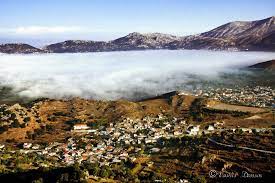Avrakontes (or Avrakonte for the locals) is a village and seat of the local community of the same name, of the Municipality of Lasithi Plateau of the regional unit (former prefecture) of Lasithi, in the region of Crete, according to the Kallikratis program.
Before the Kallikratis program and the Kapodistrias plan, it belonged to the province and Prefecture of Lasithi in the region of Crete.
The local community of Avrakonte also includes the settlement of Koudoumalia, while the population is constantly decreasing. The inhabitants are called Avrakodianoi.
Geography
On the western side of the former Prefecture of Lasithi, Avrakontes is built on a plateau, on the northern slopes of Mount Dikti (Lasithiotika), very close to the Diktaion Andron Cave. It has been characterized as a rural mountain settlement and occupies an area of 18.52 km², at an altitude of 870 m.
Name and Historical Data
The Byzantine family of the Phokades
The Phokades are one of the most important families of Byzantium and came from Cappadocia in Asia Minor. Members of the family participated in the administration of the Byzantine Empire, from the 5th century to the 11th century AD, while two of them, Flavius Phokas (602-610 AD) and Nikephoros II Phokas (963-969 AD), became emperors. From a certain Fokas, as evidenced by documents found in Avrakontes, came the branch of the Foukades family, descendants of Nikephoros Fokas. During the Turkish occupation the surname was changed to Foukarakis. In Avrakontes there is still the house that housed the “comitades” of the Foukades family.
In a Venetian document of 1545, it is mentioned that the refugee from Nafplio, Pietro Conte, was granted estates on the Lasithi plateau. This strengthens the hypothesis that the name of the village comes from a certain Abraham Conte, a relative of or the same person as that mentioned in the document. In any case, the area was deserted in 1343 and began to be repopulated after 1463. Castrofilaca, in 1583, and the Venetian Francesco Basilicata (1630) named the settlement as Metochio Anavrakonta.
It is mentioned in the Turkish census of 1671 and the Egyptian census of 1834. To the west of the village there are remains of a Venetian-era settlement at the location “Magazedes”, which would obviousy have been a grain warehouse. During the Greek Revolution, the village was repeatedly set on fire, in 1823, and later, in 1867. During the Italian-German occupation, the rebels had their hideout nearby and with sabotage, arson, kidnappings (Karta, Kraipe)fought the conquerors. In their resistance they were helped by the inhabitants of the villages of the Plateau, among whom were many Avrakodians and Koudoumatians.
Other information
In the past, every 4 years, artisans from the west of the village operated a pottery workshop where they made, dried and baked various clay items: pots, jars, flower pots, etc., and sold them all over Lasithi. The village has a special architecture, with the first houses having been built with very simple materials (stones, mud, soil and wood). They were low, rectangular, with three rooms and few or no windows, and with a door made of local thick timber. They were built in a circle close to each other, offering security to the inhabitants from the attacks of various enemies, so that they could escape easily.
Population trend according to the censuses:
| Census | 1951 | 1961 | 1971 | 1991 | 2001 | 2011 |
| Population | 794 | 551 | 489 | 385 | 195 | 170 |
